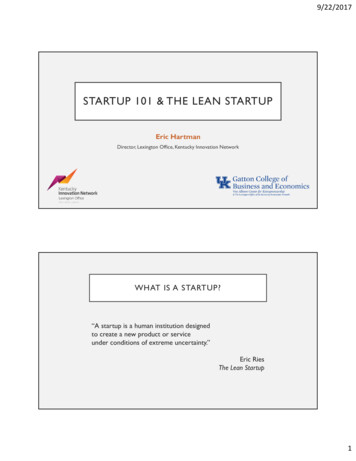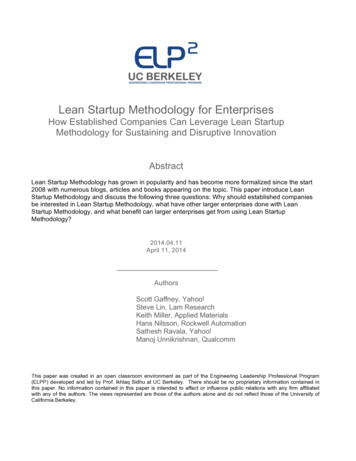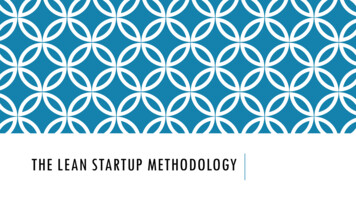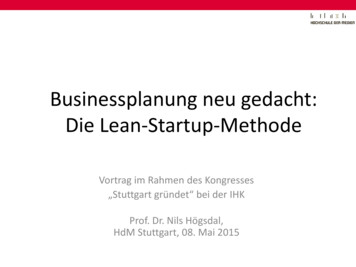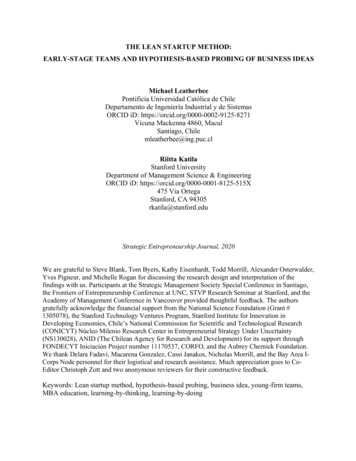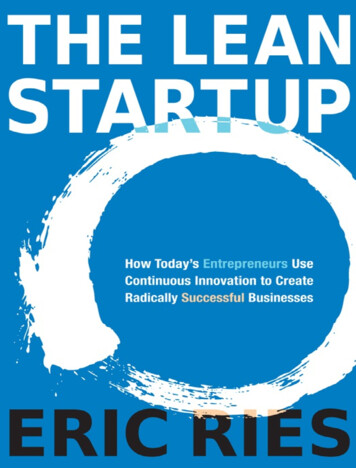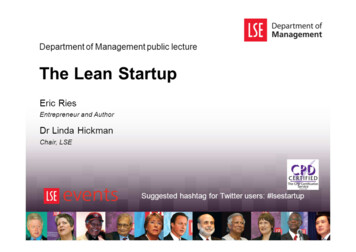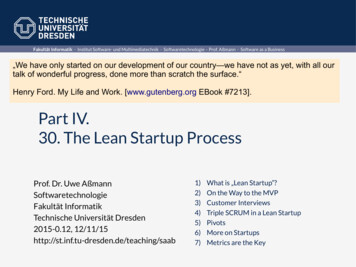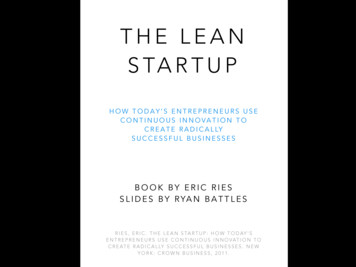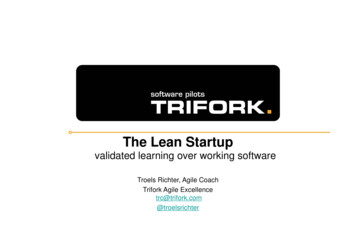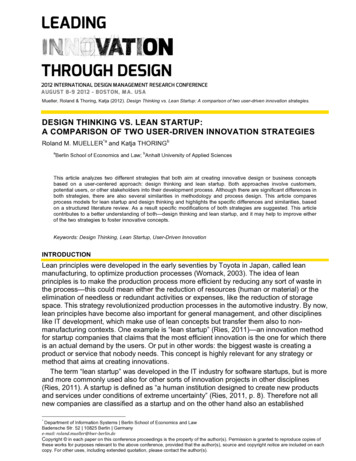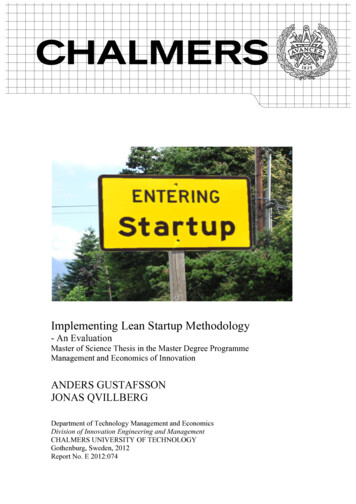
Transcription
Implementing Lean Startup Methodology- An EvaluationMaster of Science Thesis in the Master Degree ProgrammeManagement and Economics of InnovationANDERS GUSTAFSSONJONAS QVILLBERGDepartment of Technology Management and EconomicsDivision of Innovation Engineering and ManagementCHALMERS UNIVERSITY OF TECHNOLOGYGothenburg, Sweden, 2012Report No. E 2012:074
2
MASTERS THESIS E 2012:074Implementing Lean Startup Methodology- An EvaluationANDERS GUSTAFSSONJONAS QVILLBERGTutor, Chalmers: Marcus LinderExaminator: Sofia BörjessonDepartment of Technology Management and EconomicsDivision of Innovation Engineering and ManagementCHALMERS UNIVERSITY OF TECHNOLOGYGothenburg, Sweden 20123
Implementing Lean Startup Methodology- An EvaluationAnders GustafssonJonas Qvillberg Anders Gustafsson, Jonas Qvillberg 2012Master’s Thesis E 2012:074Department of Technology Management and EconomicsDivision of Innovation Engineering and ManagementChalmers University of TechnologySE-412 96 Göteborg, SwedenTelephone: 46 (0)31-772 1000Chalmers ReproserviceGöteborg, Sweden 20124
AbstractThe Startup Methodology (LSM) has recently gained a lot of attention among entrepreneurs forhow to manage new ventures. LSM is a breed of literature that provides normative guidelines toentrepreneurs for how to systematically test and refine business model hypotheses. However,limited academic research has been conducted to assess the validity of LSM. The purpose of thismaster thesis was to identify and evaluate barriers to implement LSM for early-phasemanufacturing ventures. The study was conducted by an action research methodology whereLSM was firstly compiled into a number of principles. These principles were implemented for acase company in order to evaluate barriers to implementation. Data was collected through diarykeeping and 69 semi-structured interviews.Barriers connected to particularly four principles of LSM were identified. First, LSM calls forrapid iteration and quick feedback which was inhibited by physical distribution channels.Second, principle of pivot if necessary if scalable business model cannot be identified wasassociated with two barriers; lack of big customer problems and lack of scalable businessmodels due to disparate customer processes. Third, the minimum viable product had threebarriers connected to it; an inability to quickly create prototypes, which could be attributed tocomplex products and physical distribution channels, customers’ importance of reliability, andfinally creating a general minimum viable product due to customers’ disparate processes.Fourth, LSM advocates for early customer interaction for which two barriers were identified;finding an opportunity, which are connected with high variation and complexity in customerprocesses, and accessing customers connected to few customers and challenges to contact them.Finally, a number of suggested guidelines are provided for how new ventures can overcome theencountered challenges associated with the implementation of LSM in order to find a better fitbetween customer need and technology.5
AcknowledgementsFirst of all, we would like to thank our supervisor Marcus Linder at Chalmers University ofTechnology. Linder proved to be a helpful guide in the completion of this thesis, especially inhelping us to maintain an academic mindset when we were getting too practical. Secondly, wewould like to extend our gratitude to InCorp for giving us the opportunity to write this masterthesis with them, and making us feel welcomed and appreciated along the way. A special thanksgoes to the business area manager and sales manager who always were available to answerquestions and provide support. Last but not least, we are very grateful to all the participatingcompanies and experts across the manufacturing industry for their time and information.Göteborg, June 2012Anders Gustafsson and Jonas Qvillberg6
Table of Contents1Introduction .91.11.1.12Purpose and research question .111.3Disposition .12Literature .12Related literature .132.1.1Business planning.132.1.2Entrepreneurial decision-making .142.1.3Discover opportunities .162.22.2.12.3Lean Startup methodology framework.17LSM principles.20The Lean Startup methodology process .212.3.1Phase 1: Create and validate the problem hypothesis .222.3.2Phase 2: Create and validate the solution.26Research methodology .333.1Research approach and design .343.1.1The LSM process .383.1.2The role of the InCorp employees.393.24Case company background.111.22.13Background .10Data collection.403.2.1Evaluation of LSM .403.2.2LSM process.413.3Data analysis .433.4Reliability and validity .43Empirical results.464.1Phase 1: Create and validate the problem hypothesis .467
4.1.1Find problems and creation of the hypotheses .464.1.2Finding and contacting potential customers.484.1.3Validating the hypotheses .494.1.4Exploration of market attractiveness.514.24.2.1Pre-test: Develop a Minimum Feature Set (MFS) hypothesis .524.2.2The virtual prototype test/Creation of the Minimum Viable Product .544.3567Phase 2: Create and validate the solution.52Barriers encountered during LSM implementation.564.3.1Iterate rapidly and pivot if necessary .564.3.2Iterative development of minimum viable product .574.3.3Get out of the building .57Discussion – lessons learned .585.1Iterate rapidly and Pivot if necessary .585.2Minimum Viable Product.605.3Get out of the building .635.3.1Opportunity discovery.645.3.2Access to customers .665.3.3Risk of reveling secret material.685.3.4Importance of early market sizing.69Conclusion.716.1Academic contribution .726.2Managerial implications.73Reference list.768
List of FiguresFigure 1. The customer development model by blank (2006) .19Figure 2. The OODA-cycle and the Build-Measure-Learn feedback loop .20Figure 3. The LSM process .22Figure 4. Characteristics of earlyvangelists .24Figure 5. The build-measure-learn feedback loop .29Figure 6. The market infrastructure.31Figure 7. The problem solving interest in action research .36Figure 8. The research interest in action research .36List of TablesTable 1. Summary of LSM authors.33Table 2. Overview of the tested LSM process .39Table 3. Summary of interviews conducted during the LSM process .429
1IntroductionThis section includes an introduction to the research problem along with the purpose andresearch question of this master thesis.1.1 BackgroundTechnological innovation and entrepreneurship are considered to be key factors to nationaleconomic growth (Crosby, 2000; Solow, 1956; Nadiri, 1993). Inability to exploit technologicalopportunities that occur and lack of innovative efforts can cause slow growth in countries(Fagerberg, Guerrieri & Verspagen, 2000). Unfortunately, a majority of new enterprises failwithin the first years of existence. Statistics show that about a third of the Swedish firms startedin 2005 had failed three years later (Hjalmarsson, 2010), and similar numbers can also be foundfor U.S. start-ups (Shane, 2008).The remarkable high failure rate for new companies has received much attention during the lastdecades. A considerable amount of effort has been devoted to the identification of factors,conditions and characteristics which promotes new venture creation and contributes to theirsuccess (e.g. Watson, Scott & Wilson, 1998; Zimmerman & Zeitz, 2002; Barron & Hannan,2002; Ensley, Peers & Hmiellski, 2006; Brinchmann, Grichnik & Kapsa 2010). Even thoughthis literature provides a theoretical perspective of characteristics that promotes new ventures,actual protocols for implementation are not evident. However, some academic authors have alsobeen starting to develop more normative guidelines for entrepreneurial decision-makingfollowing a Popperian approach (e.g. Harper, 1999; Sull, 2004; McGrath & MacMillan, 1995).A new breed of literature emerged in the 2000s with Steven Blank in front, literature thatprovided a stronger focus on actual implementation and hands-on recommendations forentrepreneurs. In this thesis, this literature will be grouped together under the name Lean StartupMethodology (LSM), a name that became popularized by the Silicon Valley entrepreneur ErikRies in his blog and his subsequent book “The Lean startup” from 2008. The theory emphasizesthe importance of learning from the customers to produce a solution based on customer needsand wants. This is done through an iterative process where problem, product and customerhypotheses are developed and validated. The theory also puts emphasis on building prototypesof important features to minimize waste, thus resulting in less time and money spent, whichfurther enables more iterations (Ries, 2011; Furr & Ahlstrom, 2011; Blank, 2006).However, even though this customer-centric and hypothesis-driven business developmentmethodology has gained a lot of attention, there is a dearth of academic research on themethodology. There have been some articles written about lean product development process10
(e.g. Karlsson & Åhlström, 1996; Oppenheim, 2004) but not how these principles can beapplied in a start-up context. Further, the methodology is also mainly focused on companieswithin the IT industry developing software. Research within this field would therefore help toincrease the understanding of the methodology and evaluate whether it is applicable for themanufacturing sector. The main difference between software startups and manufacturingindustries are that the manufacturing industry produce physical products while the softwareindustry produce digital products. Further, this fact implicates the available distributionchannels. A physical product demands a physical distribution channel, while a company canchoose a digital distribution channel in the software industry. This would thus be valuable andinteresting to investigate from the perspective of both practitioners as well as academia. In orderto evaluate the appropriateness of the methodology in the manufacturing sector, an in-depth casestudy of the early-stage company InCorp (fabricated company name due to secrecy) wasconducted.1.1.1 Case company backgroundThe master thesis was performed together with InCorp. The company (started in 2005) hasdeveloped a proprietary metal composition together with a unique manufacturing method, whichallows lower energy consumption, possible efficiency and quality wins as well as less need forspace. The company’s system is today used in early applications primarily for induction heatingsystems (focus area), but also for electromagnetic components.InCorp needed help to analyze the market and identify potential applications for the company’snew technology. Furthermore InCorp wanted to know about common customer problems andhow to solve them in the best way. The question was thus how the company both can createvalue for customers and how that value can be appropriated. Most of the early applications hadbeen highly customized to meet customers’ individual needs and demands in a wide range ofbusinesses. The systematic and iterative learning- and discovery process of LSM was thereforepursued to identify common customer problems and how InCorp’s technology could be used tosolve these problems and hence create customer value. By targeting specific customer segment,common needs and wants could be identified, which could simplify the selling process forInCorp and thereby facilitate better opportunities for growth. Our experiences and findings fromthe case study were then used as a basis of an evaluation of the first phases of LSM for smallmanufacturing firms with physical products. The first phases include the Customer Discoveryphase in the book by Blank (2006) or/and up until Nail the Solution/Nail the Go-to-MarketStrategy of Furr and Ahlstrom (2011).1.2 Purpose and research question11
The purpose of this thesis is to explore challenges when implementing principles of LSM forearly-phase manufacturers of physical products with a new technology facing high degree ofuncertainty about customer need and potential applications. Furthermore we will suggest howthese firms can overcome challenges with LSM to find a better fit between customer need andtechnology.To be able to fulfill the overall purpose of the thesis, the following research question will beanswered:- What are the barriers to implement LSM for InCorp and why is this the case?1.3 DispositionThis thesis is structured in five different chapters. First, a literature section is presented thatbegins with a presentation of literature related to the subject and then continues with anoverview of LSM. Second, the research methodology is presented including the researchapproach and design, data collection, data analysis and a discussion about the reliability andvalidity of the thesis. Third, the empirical results contain the derived information from the casestudy. It is divided in three parts; create and validate the problem hypothesis, create and validatethe solution, and then problems occurred during LSM implementation. Fourth, the discussion ispresented that is divided after the principles that were hard to implement; iterate rapidly andpivot if necessary, minimum viable product and get out of the building. Lastly, the conclusion ispresented including a discussion of this thesis’s academic contribution and managerialimplications.12
2LiteratureThis section consists of an overview over relevant literature and the framework used to performthe case study. . First, literature related to LSM will be presented, mainly academic literatureconcerning entrepreneurial decision-making. Second, the literature of LSM is synthesized intothe framework used in the case study at InCorp.2.1 Related literatureThe discussion of how to successfully bring a new product to the market has been present formany decades. The traditional product development model applied by numerous companies andentrepreneurs starts with the identification of an opportunity, followed by creation ofspecifications, building the product and finally selling it to customers (Blank, 2006; Furr &Ahlstrom, 2011). Authors like Cooper (1986) and Schilling & Hill (1998) highlightedmodifications of the traditional product development model, but the foundations remained thesame. Furr & Ahlstrom (2011) argue that the most common process for entrepreneurs to starttheir businesses has the same characteristics as the traditional product development process.Like in the traditional product development it starts with identifying an opportunity, raisingmoney, developing the product, refining the product for the broad appeal and then selling theproduct. Except from an initial market sizing and early customer interviews, customers are oftennot involved until the end of the process when a substantial amount of money has been invested.(Blank, 2006; Furr & Ahlstrom, 2011)However, even though this process may make sense for ongoing business focused on executionon relatively known problems, it is less appropriate for new ventures (McGrath & MacMillan,1995; Furr & Ahlstrom, 2011). New ventures are often characterized by a high degree ofuncertainty with a lot of unknowns, meaning that new ventures are often based on assumptions.The critical task for entrepreneurs is thus to effectively manage the uncertainty associated withthe creation of a new venture (Sull, 2004). A topic that has been increasingly discussed byresearchers is the role of planning in new venture creation given the high degree of uncertainty.2.1.1 Business planningA common advice to entrepreneurs is to write a solid business plan before they launch their newventures (Lange et al, 2007; Furr & Ahlstrom, 2011). Writing business plans has traditionallyeven been considered to be the most important feature of entrepreneurship courses byentrepreneurship educators (Hills, 1988). Even though business plans have become deeplyrooted as a key component for new ventures, the importance of business planning for start-upshas been discussed and questioned during the last years (e.g. Blank, 2006; Ries, 2011).13
The debate about business planning for new firms can be categorized into two broad groups.The proponents of business planning argue that a systematic, prediction-oriented and formalplanning approach results in superior venture performance (Brinckmann, Grichnik & Kapsa,2010). The other group of researchers argues that entrepreneurs instead should be focused onflexibility, learning and controlling resources (Brinckmann, Grichnik & Kapsa, 2010). Criticsprimarily consider formal business plans to be an important requirement when entrepreneursseek formal venture capital for the new ventures (Lange et al., 2007; Zacharakis & Meyer, 2000;Gruber, 2007) meanwhile the business plan itself is not perceived to be a key determinant forsuccess (Lange et al, 2007; Bhide, 1999). Too rigorous planning in early phases has even beenconsidered to be “at worst, fundamentally misleading” (Alvarez & Barney, 2007, pp. 12) and“will almost always lead to failure” (Furr & Ahlstrom, 2011, pp. 10).The traditional recommendation to entrepreneurs of writing business plans is not perfectlysuitable for start-ups, which face a high degree of uncertainty. The absence of a business plan orresearch and planning can in these cases be economically reasonable due to economicconstraints that limit the entrepreneur’s opportunity to afford much prior research and analysis(Bhide, 1999). Business planning can result in cognitive rigidities where entrepreneurs areunable to change direction (Vesper, 1992). Further, McGrath and MacMillan (1995) argue thatconventional planning approaches, commonly applied in more mature and ongoing businesses,that tend to focus on fulfilling the plan is counter-productive since insistence on meeting theplan prevents learning. The process of how entrepreneurs discover new opportunities andappropriate them is different from the context of established companies competing in industrieswith known conditions (McGrath & MacMillan, 1995). When discussing business planning it isimportant to understand the process of how entrepreneurs learn and discover and appropriatenew opportunities. We will now continue by describing theories about entrepreneurial decisionmaking and how entrepreneurs learn by systematically test and modify hypothesis to evaluatetheir business in the marketplace.2.1.2 Entrepreneurial decision-makingIncreasing attention in recent years has been given to understand what entrepreneurs do andwhat characterizes successful entrepreneurs and the methods that they use. One central aspectwithin the field of entrepreneurial research is how opportunities are considered (Venkataraman,1997).David Harper (1999) describes the entrepreneurial discovery process by drawing upon thePopperian approach (by Karl Popper, e.g. 1999) about the growth of knowledge in order todescribe entrepreneurship and market processes. Harper’s development of the Popperianapproach was initiated as an alternative to Kirzner’s theory of entrepreneurship, which is based14
on a set of highly restrictive assumptions. According to the Popperian approach as presented byHarper, learning is a consequence of how entrepreneurs choose to test particular hypotheses inthe marketplace and how they interpret the results according to their learning methodologies.Entrepreneurship can thus be seen as a kind of scientific process of discovery and learningwhere entrepreneurs continuously select relevant conjectures to test and then make judgmentsabout revising them based on the findings. (Harper, 1999)The process of entrepreneurial learning and discovery of new problems can be described byPopper’s scientific model:Problem 1 Hypotheses 1 Test in Marketplace 1 Problem 2 Hypotheses 2 Problem n 1In the model, an initial problem is first encountered. This could for example be an attempt toappropriate the value of an invention. Harper (1999) argues that entrepreneurs develop newbusiness ideas from three main types of empirical theories; theories of latent demand (unsolvedproblems), theories of production (new combinations) and theories of governance (economictransactions). Hypotheses are then generated about how to solve this problem. These hypothesesare then tested in the marketplace where assumptions, technological feasibility etc. areevaluated. Depending on the outcome of this market evaluation, hypotheses can be refuted orvalidated leading towards a revised version of the problem. The process will then continue witha new set of hypotheses that are tested in the marketplace. Even though the entrepreneur mightsucceed in solving a particular market problem, new problems are continuously discoveredduring the process, which implies that the entrepreneur’s learning process does not have adefinite end. This model shows how the entrepreneur’s learning process is an ongoingevolutionary and endogenous process. How fast the entrepreneur can identify significant errors,respond and learn from them is determined by the entrepreneur’s methodology. Sinceentrepreneurs can learn from their mistake it is desirable for them to discover these mistakes assoon as possible due to the exponential growth of product development costs. (Harper, 1999).Another researcher that explicitly builds upon the Popperian approach in entrepreneurship isProfessor Donald Sull. Based on in-depth case studies on how startups 1 and establishedcompanies manage uncertainty, Sull (2004) suggests that entrepreneurs should manageuncertainty by taking a disciplined approach similar to the model described by Harper (1999).The approach consists of three sequential steps. The first step is to formulate a workinghypothesis or “a mental model that generally includes a definition of the opportunity, the1“A startup is a human institution designed to create a new product or service under conditions ofextreme uncertainty” (Ries, 2011, pp. 27)15
resources required to pursue it, the value that would be created if it were to be successful and aplan to pursue it” (Sull, 2004, pp. 2). The mental model has the ability to shape theentrepreneur’s behavior (Markides, 1999). The model comprises a set of implicit and explicitassumption about multiple variables (e.g. technology, demand and competition), which are alluncertain. Sull (2004) emphasizes the importance of flexibility and identification of potentialdeal killers that are likely to be fatal for the venture. The second step is to assemble resourcesthat are necessary to conduct experiments to test the hypotheses. Cash provides a hedge againstuncertainty (Sahlman, 1999), but it can also lead to additional costs (e.g. unnecessary spending)(Sull, 2004). Entrepreneurs should therefore only raise sufficient capital needed for the nextround of experiments (Sull, 2004). The last step is to design and run experiments. Ultimately,entrepreneurs have to test their plans in the marketplace through iterative series of experimentssuch as customer research, prototypes or beta customers (Sull, 2004). Depending on theoutcome of these experiments, the entrepreneur may either decide to cut their losses, revise theirhypotheses or appropriate the created value (Sull, 2004).The evolutionary process of entrepreneurial learning described by e.g. Harper (1999) and Sull(2004) have also been embraced by McGrath and MacMillan (1995) expressed in theirdiscovery-driven planning approach, which they describe as “a systematic way to uncoverdangerous implicit assumptions” (McGrath & MacMillan, 1995, pp. 46). Discovery-drivenplanning can be used to convert assumption into knowledge as the venture progress, where newdata are discovered and incorporated into the evolving business plan. The process is captured infour documents; (1) a reverse income statement consisted of assumed economics needed for theventure to be successful, (2) pro forma operations specs that include the activities needed to runthe venture, (3) a key assumptions checklist that entrepreneurs use to assure that importantassumptions on which the venture’s success depends on are checked during the process and (4)a milestone planning chart which specifies when specific assumptions should be checked. Thisprocess can thus help the entrepreneur to test underlying hypotheses and correct the businessmodel in light of new information and thereby abandon poor concepts before major investmentshave been made. (McGrath & MacMillan, 1995)Even though these authors provide frameworks of how entrepreneurs continuously develop andtest their hypotheses in an uncertain environment, little is said about how the entrepreneurdiscover the initial opportunities that are later tested and adjusted depending on the outcome ofthe experiments. As finding an opportunity is the starting point of a startup it is central to havean understanding of it to be able to evaluate startup methodology.2.1.3Discover opportunities16
There are different theories for finding new opportunities. The leading management schools inthe world mainly teaches students casual reasoning (Sarasvathy, 2001). Casual reasoning meansthat you have a pre-determined goal and the challenge is to fin
Ries in his blog and his subsequent book “The Lean startup” from 2008. The theory emphasizes the importance of learning from the customers to produce a solution based on customer needs and wants. This is done through an iterative process where problem, product

